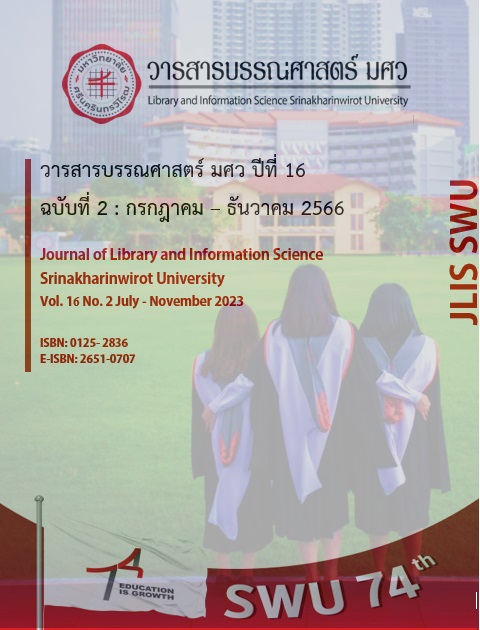การพัฒนาปฏิบัติการฟิสิกส์พื้นฐานด้วยการใช้สื่อจำลองโต้ตอบเสมือนจริง
คำสำคัญ:
เทคโนโลยีฟิสิกส์ศึกษา, สื่อจำลองโต้ตอบเสมือนจริง, ปฏิบัติการฟิสิกส์บทคัดย่อ
งานวิจัยนี้ได้นำเสนอผลการพัฒนาปฏิบัติการฟิสิกส์ด้วยการใช้สื่อจำลองโต้ตอบเสมือนจริง โดยใช้สื่อจากโครงการ Physics Education Technology (PhET) ซึ่งประกอบด้วยสื่อจำลองโต้ตอบเสมือนจริงมากกว่า 50 สื่อจำลอง บนเว็บไซต์ www.phet.colorado.edu สื่อจำลองโต้ตอบเสมือนจริงประกอบด้วยสื่อจำลองในวิชา ฟิสิกส์ ชีววิทยา เคมี วิทยาศาสตร์โลก และ คณิตศาสตร์ บทความวิจัยนี้ได้นำสื่อจำลองโต้ตอบเสมือนจริงมาทำการออกแบบและจัดทำแบบบันทึกผลการทดลองเพื่อนำมาใช้ในการจัดการเรียนการสอนในรายวิชาปฏิบัติการฟิสิกส์พื้นฐานจำนวน 4 ปฏิบัติการประกอบด้วย 1) การเคลื่อนที่ด้วยความเร่ง 2) การเคลื่อนที่แบบสั่นแกว่งอย่างง่าย 3) กฎของโอห์ม และ4) แรงเคลื่อนไฟฟ้าและความต้านทานภายใน ผลจากการศึกษาพบว่า นักศึกษามีคะแนนเฉลี่ยหลังเรียนสูงขึ้น และมีค่าเฉลี่ย Normalize gain อยู่ในระดับปานกลางเท่ากับ 0.43 นักศึกษาที่เรียนโดยใช้สื่อจำลองโต้ตอบเสมือนจริงในการทำปฏิบัติการฟิสิกส์พื้นฐานให้ผลตอบรับในเชิงบวก ซึ่งส่งผลอย่างชัดเจนว่าการใช้สื่อจำลองโต้ตอบเสมือนจริงสามารถส่งเสริมการเรียนรู้ของนักศึกษาในเรื่องการทำปฏิบัติการฟิสิกส์ ช่วยให้นักศึกษาสามารถสร้างมโนมติทางฟิสิกส์ มองเห็นภาพได้ชัดเจนและนำไปประยุกต์ใช้ในชีวิตประจำวันได้
เอกสารอ้างอิง
Baltzis, K.B., & Koukias, K.D. (2009). Using Laboratory Experiments and Circuit Simulation IT Tools in an Undergraduate Course in Analog Electronics. Journal of Science Education and Technology, 18(6), 546-555.
Banda, H.J., & Nzabahimana, J. (2023). The impact of physics education technology (PhET) interactive simulation-based learning on motivation and academic achievement among malawian physics students. Journal of Science Education and Technology, 32(4), 127-141.
Chuaon, S. (2011). Effectiveness of laboratory group investigation model in science classroom. Veridian E-Journal SU, 4(1), 645-651. (In Thai)
Clarkt, T.M., & Chamberlain, J.M. (2014). Use of a PhET interactive simulation in general chemistry laboratory: Models of the hydrogen atom. Journal of Chemical Education, 91(8), 1198-1202.
Jansoon, N., & Rakbamrung, N. (2018). TPACK in chemistry classroom using PhET interactive simulations. Journal of Science and Science Education, 1(1), 109-121. (In Thai)
Ogegbo, A.A., & Ramnarain, U. (2022). Teaching and learning Physics using interactive simulation: A guided inquiry practice. South African Journal of Education, 42(1), 1-9.
Perkins, K., Adama, W., Dubson, M., Finkelstein, N., Reid, S., Wieman, C., & LeMaster, R. (2006). PhET: interactive simulations for teaching and learning physics. The Physics Teacher, 44(18), 18-23.
Phuaphan, N., Kijkuakul, S., & Chanunan, S. (2020). Development of an innovative methods course supporting pre-service science teachers’tecchnological pedagogical and content knowledge: A critical participatory action research. Journal of Education Naresuan University, 24(2), 159-169, (In Thai)
Rehman, N., Zhang, W., Mahmood, A.K., & Alam, F. (2021). Teaching Physics with interactive computer simulation at secondary level. Brazilian Journal of Education, Technology and Society, 14(1), 127-141.
Saiyasit, P., & Suwanno, P. (2021). Assessment of the current state and needs related to development of information and communication technology skills in 21st century learning management for municipal school teachers, The local administrative organization, Yala Province. Journal of Library and Information Science Srinakharinwirot University, 14(2), 24-34. (In Thai)
Thanetweeraphat, A. (2022). Teaching techniques for designing physics learning activities during the COVID-19 pandemic: Analysis of pre-service teachers’ lesson plans. Journal of Education Study, 50(4), 2-13. (In Thai)
Wood, B.K., & Blevins, B.K. (2019). Substituting the practical teaching of physics with simulations for the assessment of practical skills: an experimental study. Physics Education, 54(3), 035004.
ไฟล์ประกอบ
เผยแพร่แล้ว
ฉบับ
ประเภทบทความ
สัญญาอนุญาต
ลิขสิทธิ์ (c) 2023 คณะมนุษยศาสตร์ มหาวิทยาลัยศรีนครินทรวิโรฒ

อนุญาตภายใต้เงื่อนไข Creative Commons Attribution-NonCommercial-NoDerivatives 4.0 International License.
เกี่ยวกับลิขสิทธิ์
ลิขสิทธิ์ของบทความที่ปรากฏในวารสารบรรณศาสตร์ มศว เป็นของผู้นิพนธ์และคณะมนุษยศาสตร์ มหาวิทยาลัยศรีนครินทรวิโรฒ ทั้งนี้ บทความทุกเรื่องผ่านการตรวจสอบความถูกต้องทางวิชาการจากผู้ทรงคุณวุฒิ ข้อความและข้อมูลของบทความในวารสารฯ เป็นแนวคิดของผู้นิพนธ์ มิใช่เป็นความคิดเห็นของกองบรรณาธิการและมิใช่ความรับผิดชอบของคณะมนุษยศาสตร์ มหาวิทยาลัยศรีนครินทรวิโรฒ ไม่สงวนลิขสิทธิ์การนำไปใช้ประโยชน์ทางวิชาการ แต่ต้องอ้างอิงแสดงแหล่งที่มาและที่อยู่ในขอบเขตของกฎหมายลิขสิทธิ์



